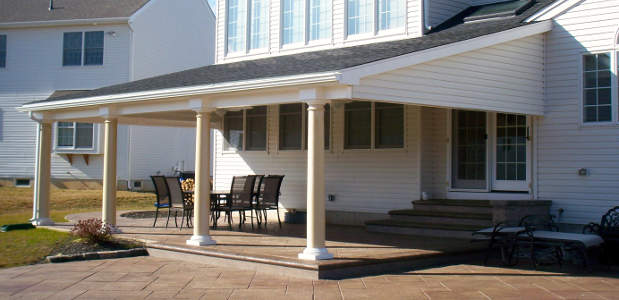
A patio is an excellent space for all sorts of activities. Of course, a patio can be the perfect setting for a small outdoor gathering or an intimate fresh-air meal, but it can also be used for messy projects that simply don’t fly indoors like woodworking or children’s arts and crafts. Patio enclosures bring even more versatility to this already flexible space, and some supplemental outdoor heating can make the space an outdoor refuge even during the winter months. Your design can be as simple or elaborate as you like, but if you want the most resale value and sharpest appearance, good planning is almost always the deciding factor.
Patio Roofs
The patio roof you choose will have an impact on how and when the space can be used. Wood with asphalt shingles is a popular choice in areas where snow is common, as it can bear the extra weight as easily as the roof on a typical house. In areas where sun is the main attraction, retractable fabric awnings might be a better material, as they are more affordable and offer more flexibility than permanent framed patio roofing. Those who view the patio as a perfect place to grow plants might consider clear plastic or glass roofing to turn the space into a veritable greenhouse; for others, the lasting durability and performance of sheet metal might be the best choice. No one roof is the absolute best for every situation, so make sure to discuss this decision with your contractor before setting your heart on any one material.
Patio Enclosures
One of the most important decisions you’ll make for your patio (both practically and aesthetically) involves you enclosure. Lightweight, inexpensive plastic enclosures are probably the easiest to set up, but they often lack the elegance and durability of other options. Some patio enclosures are created using the same materials and techniques as the other exterior walls of a house, and are just as attractive and durable, but their construction is lengthy, costly, and less flexible.
More formidable enclosures are often worth the effort and investment for those who plan on using their patios regularly all year round, but are probably a bit too pricey for homeowners who are simply looking for a dry outdoor area to read a book or play cards. In many cases, the most effective patio enclosures are those that combine elements of conventional home construction with the affordability of newer plastic and fiberglass materials. Having the bottom half of your patio walls built like those in your house will allow you to easily and invisibly set up electrical wiring and gas lines (if desired) while still leaving plenty of room for less expensive, more versatile glass or plastic barriers above.
Ready to start your Patio Enclosure?
Find ProsBrick and Stone Patio Pavers
Patios of the past were often constructed on a single concrete slab. While this option is still alive and well, many of today’s homeowners view patio space as another room of their home, and want it look the part. Cultured and natural stone patio pavers are the choice of many such homeowners for a variety of reasons. Just like the elegance granite and quartz counters bring to kitchens and bathrooms, cultured and natural stone patio pavers are high-quality, attractive materials that add a touch of class to your outdoor living area. Natural stone patio pavers are not the cheapest option out there, but when you compare the look of stone pavers to your average concrete slab, it is quickly apparent what those extra dollars provide.
For environmentally conscious homeowners, recycled brick patio pavers are an option that’s well worth looking into. Recycled brick patio pavers are actually “harvested” from old roads that are under construction. While the heavy brick that exists underneath some old roads might once have been simply thrown out, this durable material can be refurbished to create brick patio pavers that are as attractive as they are eco-friendly. Just because they were once considered waste, however, doesn’t mean that recycled brick patio pavers are going to be dirt cheap. Though you might be able to find someone who will allow you to haul away old road pavers “as-is” for a relatively low price, in most cases, the cost of making recycled brick pavers attractive again is passed on to the consumer.
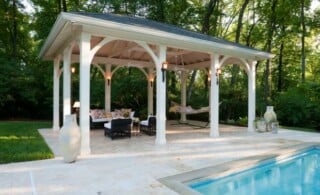 Cleaning Your Exteriors With a Pressure Washer
Cleaning Your Exteriors With a Pressure Washer 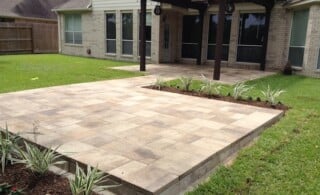 Resurfacing an Outdoor Patio
Resurfacing an Outdoor Patio 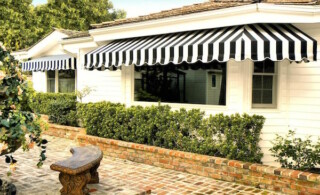 Types of Awnings
Types of Awnings  Outdoor Heaters: a Refuge from the Cold
Outdoor Heaters: a Refuge from the Cold 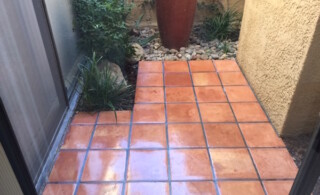 Mexican Pavers for that South of the Border Feel
Mexican Pavers for that South of the Border Feel 

Are You Familiar With This Topic? Share Your Experience.